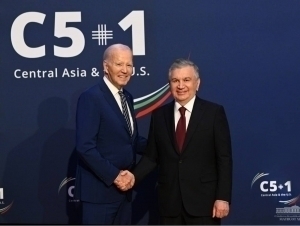USA is repairing Uzbekistan’s aging gas system from the USSR Era
Local
−
25 September 2024 25946
Uzbekistan’s gas pipelines, built during the Soviet Union and now outdated, suffer from about 50,000 gas leaks, resulting in an estimated $10 million in wasted budget funds annually. This data was provided by GasGreen Asia, a U.S. company with 20 years of experience. In response, Uzbekistan’s “Hududgaztaminot” joint-stock company signed a contract in 2023 to address these leaks.
“This project marks the first year of our 11-year effort, in collaboration with Hududgaztaminot, to detect and repair leaks throughout Uzbekistan’s gas distribution system. In the past year alone, we’ve identified and repaired over 52,000 individual gas leaks across the country. Some of these leaks were found at major gas distribution points, and even near people’s homes, including in gas regulators attached to their houses.
We estimate that the project has saved Uzbekistan $100 million worth of gas that would have been lost due to leaks. This effort is not only crucial for the health and safety of local residents, helping to prevent gas poisoning, but also represents a huge environmental win. Methane released into the atmosphere contributes to climate change and global warming. Addressing these leaks helps mitigate these issues, which are particularly sensitive for the region and could lead to water shortages and other problems in the coming years,” James highlighted the significance of the repairs.
James also shared that two months ago, he was invited to speak about the project at the White House in Uzbekistan, where they were interested in replicating this success in other countries. He added, “The reduction in methane emissions achieved through this project is equivalent to 7.8 million tons of CO2 per year, which is a substantial achievement. This is not just a one-time effort; we’ve committed to another 10 years of work in Uzbekistan.”
On September 24, a meeting was held at the U.S. ambassador's residence in Tashkent to mark the one-year anniversary of the contract. During the event, officials answered questions from Uzbek government representatives. Ravshan Gulomov, an economic and social adviser to the President of Uzbekistan, asked for details on GasGreen Asia’s approach and the longevity of the patched pipelines.
“Let’s say this gas pipe is leaking—how much does it cost to patch it, and how long will the repair last?” Gulomov asked.
"The process begins with a sensitive machine that detects gas leaks. “Currently, we use only the second machine of its kind, made in the USA, which measures how many liters of methane are leaking per minute. We then document the amount of CO2 equivalent emissions being released annually. Advanced repair materials are used to fix the leaks, and we revisit these repair sites at least once a year to ensure they remain in good condition. We only use the best materials in the world for these repairs,” he assured.
The concern behind Gulomov’s questions is valid—it revolves around the efficient use of millions of dollars in investment. If the 10-year project fails to deliver, both time and money will be wasted. However, officials assert that the project is already showing positive results in its early years.
"The project to address Uzbekistan’s gas leaks, a critical issue caused by aging Soviet-era infrastructure, is set to last for 10 years and cost $35 million. During 2023-2024, $8.5 million in direct investment was allocated to eliminate these leaks, with plans to invest a further $27 million over the next eight years. Zafar Jabbarov, Deputy Head of the Investment Department of "Hududgaztaminot" JSC, provided these details about the project’s cost.
However, some question whether patching holes in these old gas pipelines is the most effective use of funds. Jabbarov referenced a well-known Uzbek saying: “If you fix the old, it will be gone.” This raises the question: would it not be better to completely renew the pipelines rather than spend millions patching them?
Yes, that’s a valid point regarding the gas system, and that’s precisely why we’re here. There are opportunities to fix leaks because the system has very old equipment. I’ve been working with Uzbekistan’s gas systems for 15 years, and I’ve seen significant improvements. As these pipelines are outdated, they are being gradually renewed and new equipment is being installed. Your gas system is vast, and what we’re doing is contributing to its continuous improvement,” Kevin James, project leader from GasGreen Asia, responded.
Aziz Abdujabbarov, a representative from the U.S. company’s office in Uzbekistan, added that this "patching" process can, in fact, be seen as a form of renewal.
“Yes, we can confidently say we are renewing the old gas pipelines from the Soviet era. While the exterior of these pipes may remain unchanged, we are completely transforming their interior. We use high-quality materials that ensure the pipes don’t expand or contract under extreme weather conditions, whether during freezing winters or scorching summers,” he explained.
The issue of gas leaks also brings to mind the tragic incident at the “25 Years of Independence” mine in Boysun district, Surkhandarya region, where four people lost their lives, and several others were injured. The situation has attracted international attention, with foreign companies and governments hoping the problem can be resolved.
“There are many companies in the U.S. experienced in this area. I recently spoke with Uzbekistan’s Minister of Energy, and I know the Ministry and related agencies are in contact with U.S. companies. While I’m not familiar with the exact companies or the nature of the agreements, I’m confident they are working on resolving the issue. We all hope that no further harm will come to anyone,” said Jonathan Henick, the U.S. Ambassador to Uzbekistan.
Live
All



